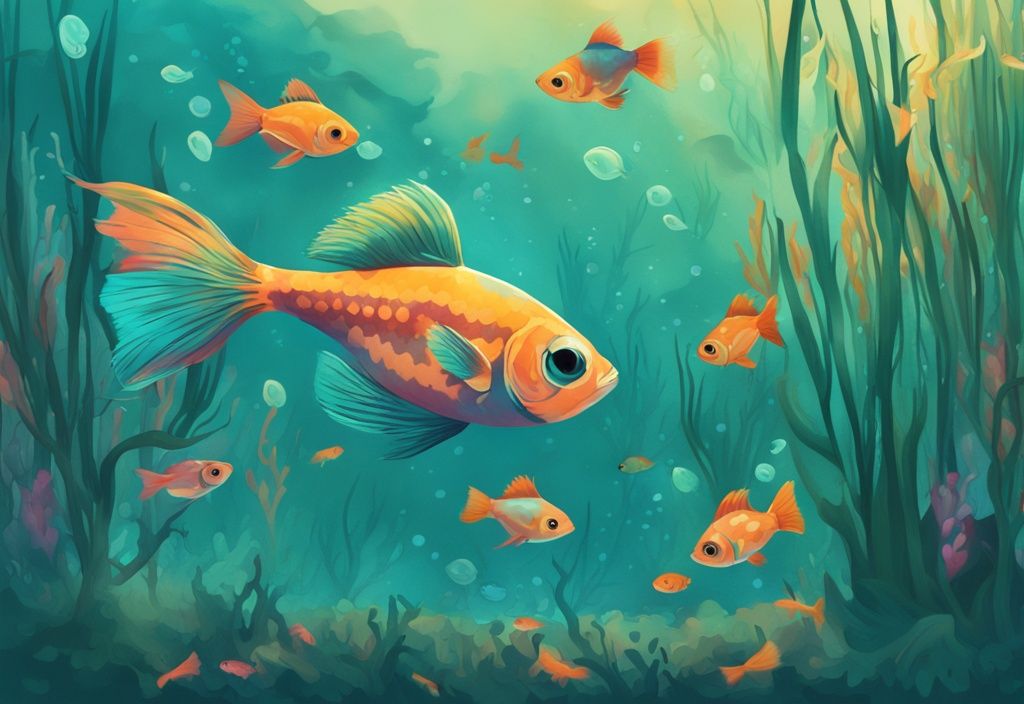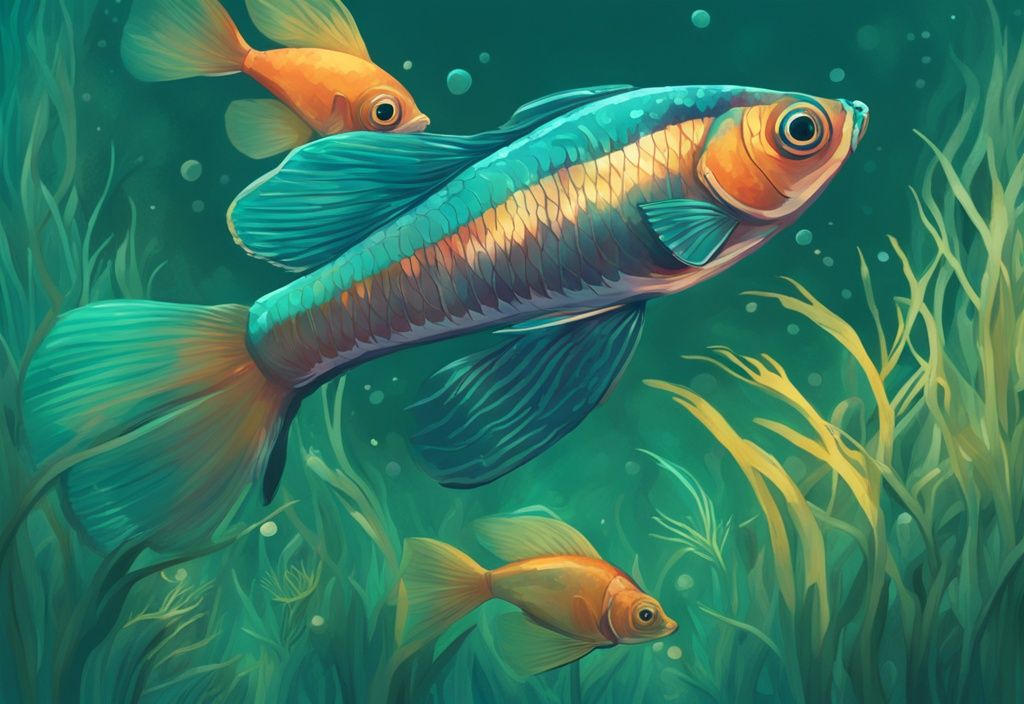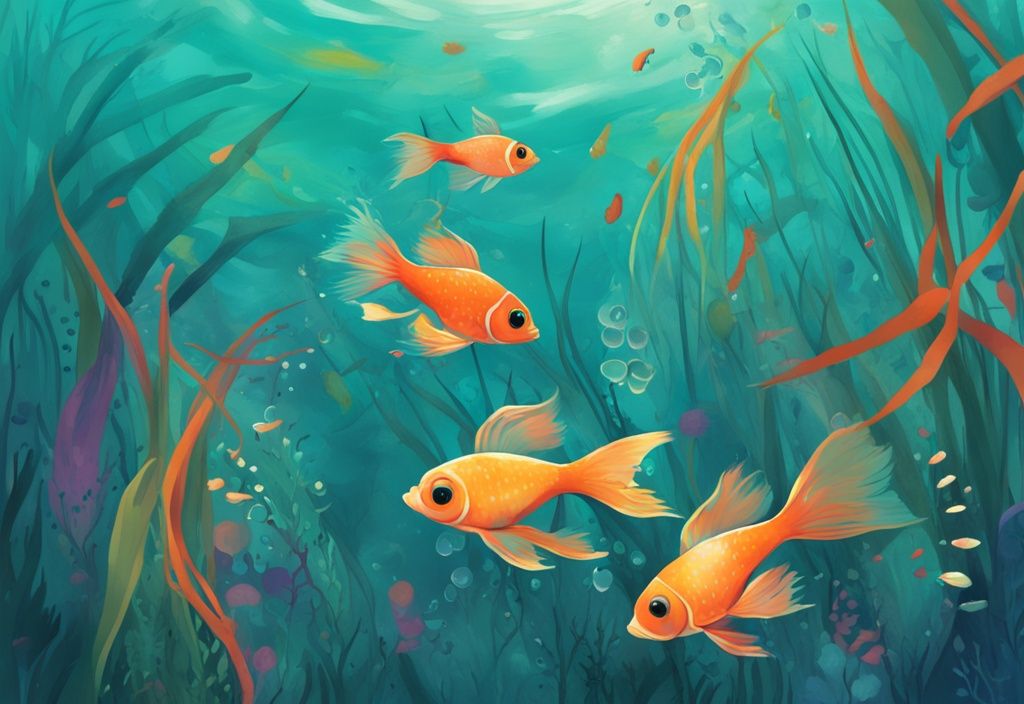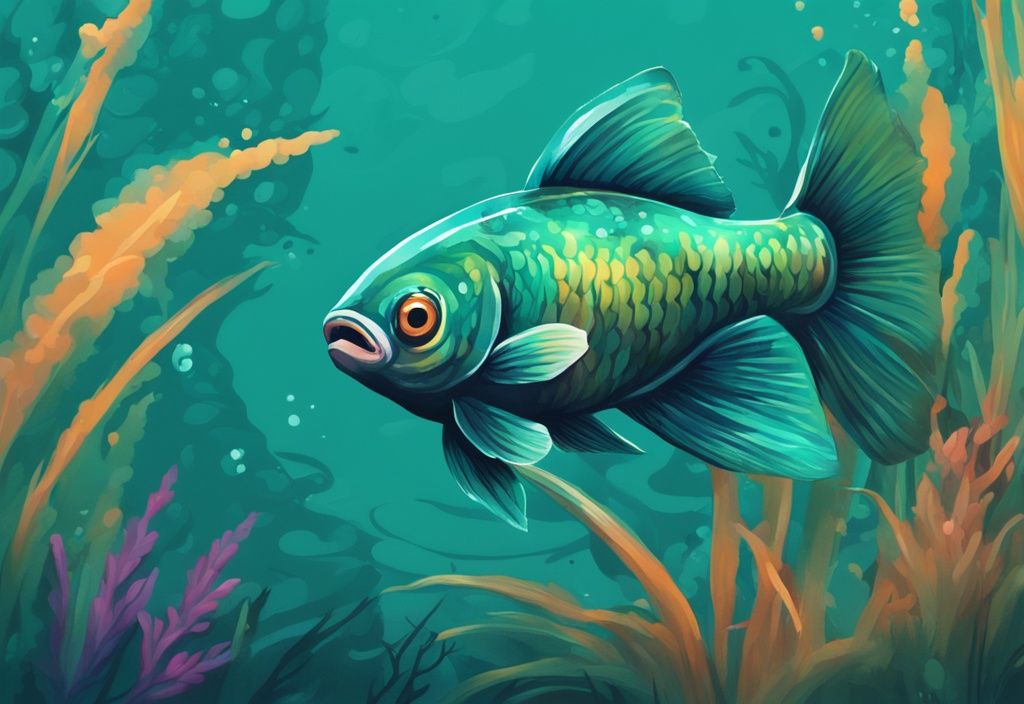Picture this: a plant that not only beautifies your aquarium but also nurtures its aquatic residents. Meet Guppy Grass, a favorite among aquarists for its remarkable benefits. Scientifically known as Najas guadalupensis, this plant is like the unsung hero of your tank, improving water quality and offering a cozy habitat for fish.
In this guide, we’ll explore the wonders of Guppy Grass, from its role in reducing fish stress to creating thriving breeding environments. With a sprinkle of humor and a dash of passion, I’ll share insights on growth conditions, compatibility, and propagation. Whether you’re a seasoned aquarist or just starting, let’s dive into the secrets of maintaining vibrant Guppy Grass and unlocking your aquarium’s full potential.
Understanding Guppy Grass: An Introduction
Guppy Grass, or Najas guadalupensis, is a beloved choice among aquarium enthusiasts. Its charm lies in its impressive growth rate and adaptability, making it a versatile addition to various aquatic environments. Whether you’re setting up a freshwater or brackish water tank, Guppy Grass offers the flexibility you need to create a thriving aquatic habitat.
Hailing from North and Central America, Guppy Grass has earned international acclaim, finding its way into aquariums worldwide. Its broad adaptability makes it an ideal plant for beginners embarking on their aquarium journey, as well as for seasoned aquarists seeking a dependable, low-maintenance option.
Beyond its adaptability, Guppy Grass plays a crucial role in maintaining ecological balance within aquariums. Its rapid growth aids in nutrient absorption, helping to maintain water quality and keep pesky algae at bay. This, combined with its ability to provide shelter and breeding grounds for fish, highlights its importance in fostering a vibrant and balanced aquatic ecosystem.
Why Guppy Grass? Key Benefits for Your Aquarium
Improving Water Quality with Guppy Grass
Guppy Grass is like the unsung hero of aquarium plants, quietly working behind the scenes to enhance water quality. Imagine it as a natural vacuum cleaner, absorbing excess nutrients and reducing the risk of pesky algae blooms. This keeps your water crystal clear and your aquatic friends happy. Plus, Guppy Grass is a pro at oxygenating the water, ensuring your fish have plenty of fresh air to breathe. This dual action of nutrient absorption and oxygenation makes Guppy Grass a must-have for a balanced and thriving aquarium ecosystem.
Guppy Grass: A Natural Stress Reducer for Fish
Creating a stress-free environment for your fish is crucial, and Guppy Grass is here to help. Its dense growth provides perfect hiding spots, offering a sense of security for shy or easily startled fish. Think of it as a cozy blanket that mimics their natural habitat, helping them feel right at home. This protective environment is especially vital for fry, shielding them from the curious eyes of adult fish. By adding Guppy Grass, you’re crafting a serene and harmonious setting that promotes the overall health and happiness of your aquatic companions.
How Guppy Grass Supports Fish Breeding
For aquarists keen on breeding, Guppy Grass is a game-changer. Its lush foliage offers ideal hiding spots for fry, protecting them from adult fish that might see them as a snack. This safe haven is crucial for their survival and growth. Moreover, Guppy Grass supports the development of microfauna and biofilm, which are like a buffet for shrimp and other small creatures. These microorganisms provide a natural food source, enhancing the nutritional environment for fry and shrimp. By fostering a supportive breeding habitat, Guppy Grass not only aids in the survival of young fish but also contributes to a flourishing aquarium ecosystem.
Essential Growth Conditions for Guppy Grass
Guppy Grass is a versatile aquatic plant that can adapt to a variety of environments, making it a favorite among aquarium enthusiasts. Below, we delve into the key conditions that ensure its optimal growth and health.

Water Conditions: The Ideal Environment for Guppy Grass
Guppy Grass is like the chameleon of the aquatic plant world. It thrives in diverse water conditions, making it a resilient choice for any aquarium. Ideally, it prefers water temperatures between 20-26°C, which means it can comfortably fit into both tropical and temperate setups. Its tolerance to a wide pH range, from 6.0 to 8.0, allows it to blend seamlessly into various aquatic environments. This adaptability makes Guppy Grass a fantastic option for aquarists who wish to maintain diverse tank conditions without sacrificing plant health.
Light Requirements for Healthy Guppy Grass
When it comes to lighting, Guppy Grass is quite the adaptable plant. It can thrive under both low and high light conditions. While it can survive with minimal light, providing more light can significantly boost its growth, resulting in a lush, vibrant appearance. Think of it as giving your plant a little extra sunshine to keep it happy and healthy. Proper lighting not only enhances its beauty but also ensures its vitality. By maintaining suitable lighting conditions, you’ll keep your Guppy Grass looking vibrant and contribute positively to your aquarium’s ecosystem.
Fertilization and CO2: Boosting Guppy Grass Growth
Guppy Grass is not particularly fussy about CO2 or fertilization, but these elements can certainly promote more vigorous growth. In nutrient-poor waters, adding liquid fertilizers can be beneficial, supplying essential nutrients that support its development. However, it’s important to avoid overfertilization, which can lead to unwanted algae growth and other water quality issues. By finding a balance, you can optimize the growth conditions for Guppy Grass, ensuring it remains a healthy and thriving part of your aquarium.
Is Guppy Grass Compatible with Your Aquarium Life?
Guppy Grass is a versatile plant that can enhance the environment of many aquarium setups. Its adaptability makes it a favorite among aquarists who seek to create a balanced and thriving aquatic ecosystem.
Best Tank Mates for Guppy Grass
Guppy Grass is a wonderful addition to community tanks, thriving alongside guppies, shrimp, and other small fish. Its dense foliage offers a myriad of hiding spots, which is especially beneficial for livebearers. These fish, known for giving birth to free-swimming young, find the lush cover of Guppy Grass ideal for reducing stress and promoting well-being. Imagine it as a cozy underwater forest where fish can seek refuge and feel secure. The plant’s natural aesthetics and adaptability make it a popular choice for those looking to create a harmonious aquatic habitat.
Guppy Grass and Shrimp: What You Need to Know
Shrimp enthusiasts often turn to Guppy Grass for its remarkable benefits. This plant supports the growth of microfauna and biofilm, essential components of a shrimp’s diet, thus promoting their health and vitality. The intricate structure of Guppy Grass mimics natural habitats, encouraging shrimp breeding and growth. Think of it as a bustling underwater metropolis, offering both shelter and a rich feeding ground. By choosing Guppy Grass, you can foster a thriving shrimp population, ensuring a balanced and dynamic aquarium ecosystem.
Planting Guppy Grass: Propagation Techniques
Guppy Grass is a versatile plant that can thrive in various aquarium setups. Whether you choose to let it float freely or anchor it in the substrate, understanding these methods can help you create a balanced and visually appealing aquatic environment.
Floating vs. Substrate Planting: Which is Best for Guppy Grass?
Guppy Grass offers you the flexibility to choose between floating and substrate planting methods. When floating, it absorbs nutrients directly from the water, making it a low-maintenance option. This approach is perfect if you prefer a natural, free-flowing look in your aquarium. Plus, floating Guppy Grass provides an excellent refuge for fry and shy fish, giving them a safe haven.
In contrast, planting Guppy Grass in the substrate can enhance your aquarium’s visual appeal by creating a more structured and organized look. This method allows the plant to anchor itself, potentially leading to more stable growth. However, it requires a bit more attention to ensure the roots are adequately covered and secure. Both methods have their unique perks, and the choice depends on your personal preference and the specific needs of your aquarium setup.
Easy Steps for Propagating Your Guppy Grass
Propagating Guppy Grass is a breeze, making it a fantastic choice for expanding your plant collection with minimal effort. Start by selecting healthy stems from your existing plant. With clean, sharp scissors, cut the stems into sections, ensuring each piece has several leaves. These cuttings can then be replanted in the substrate or left to float, depending on your preferred method.

Regular trimming is crucial to managing the rapid growth of Guppy Grass. By consistently cutting back excess growth, you prevent the plant from overtaking your aquarium, ensuring it remains a manageable and attractive feature. This practice not only maintains the desired shape and size but also encourages new growth, keeping your Guppy Grass lush and vibrant.
Keeping Your Guppy Grass Healthy: Maintenance and Care
Guppy Grass is a fantastic addition to any aquarium, offering both beauty and function. However, like any plant, it requires some attention to thrive. Below, we’ll explore how to manage its growth and handle potential pest issues, ensuring your aquatic environment remains balanced and vibrant.
Managing Guppy Grass Growth: Trimming Tips
Guppy Grass is known for its rapid growth, which can quickly turn your tank into a jungle if left unchecked. Regular trimming is essential to keep it from taking over. Think of it like giving your aquarium a haircut—necessary for both health and aesthetics. Use sharp scissors or aquascaping tools and trim just above a leaf node. This technique encourages new shoots, leading to a lush, vibrant appearance. Regular maintenance not only keeps your tank looking neat but also supports the plant’s health, allowing it to integrate seamlessly into your aquascaping design.
How to Handle Pest Issues with Guppy Grass
Pests can be a sneaky problem for Guppy Grass, but with a few proactive steps, you can keep them at bay. Always quarantine new plants before adding them to your tank. This simple step can prevent the introduction of unwanted pests. Regularly inspect your Guppy Grass for signs of trouble, like discolored leaves or odd growth patterns. If you spot pests, opt for treatments that are safe for both plants and fish. Natural remedies or safe commercial options can be effective, but always double-check their compatibility with your aquarium’s ecosystem. This approach not only protects your Guppy Grass but also maintains the delicate balance of your aquatic environment.
Overcoming Guppy Grass Challenges
Guppy Grass, a popular choice for aquarists, presents unique challenges that require thoughtful management. Its rapid growth and sensitivity to certain treatments necessitate careful handling to maintain a balanced aquarium ecosystem. Let’s delve into how you can effectively manage these aspects.
Dealing with the Invasive Nature of Guppy Grass
Guppy Grass is like that enthusiastic friend who just can’t stop talking—it’s vibrant, lively, and sometimes a bit too much. Its rapid growth can quickly transform your aquarium into a dense jungle, which might be overwhelming for both you and your aquatic friends. Regular trimming and vigilant monitoring are key to keeping this spirited plant under control. Think of it as giving your aquarium a regular haircut to keep it looking sharp.
In some areas, Guppy Grass is considered invasive, and there might be legal restrictions on its use. It’s crucial to check local regulations before adding it to your tank. This ensures you’re not just creating a beautiful underwater world but also staying on the right side of the law. By understanding these nuances, you can enjoy the benefits of Guppy Grass without letting it take over your aquatic haven.
Understanding Guppy Grass Sensitivity to Copper-Based Medications
Now, let’s talk about Guppy Grass’s delicate side. This plant is particularly sensitive to copper-based medications, which are often used to treat fish ailments. Imagine copper as kryptonite for Guppy Grass—it can stunt its growth and even harm the plant. To protect your vibrant underwater greenery, opt for alternative treatments that are copper-free. This way, you ensure that both your fish and plants thrive in harmony.
Being aware of this sensitivity helps you maintain a healthy and balanced aquarium. It’s all about creating a space where both your aquatic plants and fish can flourish together, turning your aquarium into a serene and sustainable ecosystem.

Conclusion
Guppy Grass, or Najas guadalupensis, is a remarkable plant that brings a multitude of benefits to aquarium enthusiasts. Its ability to enhance water quality is truly impressive. By absorbing excess nutrients, Guppy Grass acts as a natural filter, preventing algae blooms and promoting a cleaner, healthier aquatic environment. This not only improves water clarity but also boosts oxygenation, creating a more hospitable space for your aquatic friends.
But the magic of Guppy Grass doesn’t stop at water purification. Its dense growth offers a safe haven for fish, reducing stress by providing ample cover and mimicking their natural habitat. This is especially crucial for fish and fry, offering them a sanctuary that fosters security and well-being.
Moreover, Guppy Grass is a boon for fish breeding. Its structure serves as a protective nursery for fry, shielding them from adult fish and other potential threats. It also supports a thriving ecosystem by nurturing microfauna and biofilm, which are essential for shrimp and other small aquatic creatures, thereby enriching the aquarium’s biodiversity.
With the right care, Guppy Grass can be an invaluable addition to any aquarium. Its adaptability to various water conditions and low maintenance needs make it ideal for both novice and seasoned aquarists. Regular trimming and monitoring ensure it remains a manageable and visually appealing part of your aquarium landscape. In essence, Guppy Grass is a versatile plant that not only enhances the health of your aquatic environment but also adds to its aesthetic charm.
FAQ
Explore common questions about Guppy Grass and learn how it can enhance your aquarium experience.
Is Guppy Grass a Good Choice for Aquarium Beginners?
Absolutely! Guppy Grass is a fantastic choice for beginners. Its adaptability is akin to a trusty old friend who fits in anywhere. Whether your water conditions are a bit temperamental or just right, this resilient plant thrives. It’s like the Swiss Army knife of aquatic plants—versatile and low-maintenance, making it a breeze for newcomers to manage.
How Often Should Guppy Grass be Trimmed?
Think of Guppy Grass as that enthusiastic friend who always grows a little too fast for their own good. Regular trimming is key to keeping it in check. By trimming frequently, you prevent it from taking over your tank like an overzealous party crasher. This ensures your aquarium remains a balanced and visually pleasing aquatic haven.
Can Guppy Grass Thrive in Low-Light Conditions?
Yes, indeed! Guppy Grass can flourish even in low-light environments, though it might take its time, much like a leisurely Sunday morning stroll. It’s a reliable option for tanks with limited lighting, maintaining its health and charm without demanding too much spotlight. For those interested in exploring more options, consider this low maintenance aquarium approach to keep your aquatic life thriving with minimal effort.
What are the U.S. Legal Restrictions on Guppy Grass?
Before you invite Guppy Grass into your aquatic family, it’s wise to check local regulations. In some U.S. states, it’s considered invasive and might be banned. Think of it as ensuring your new plant friend is welcome at the neighborhood block party. This step helps you stay compliant and environmentally responsible.
